Healthy mouths
Maintaining a healthy mouth relies upon practising good oral hygiene. Regular toothbrushing removes and controls the build-up of plaque, and helps to prevent tooth decay, gum disease and tooth loss. In Australia, it is recommended that people brush their teeth twice a day using fluoride toothpaste (Department of Health and Aged Care 2018).
Data presented in this chapter of the report has been sourced from various national population surveys. Whilst all collect information about access to and use of dental services, measures of oral health and barriers to use of dental services, the National Child Oral Health Study 2012–14, the National Survey of Adult Oral Health 2004–06 and the National Study of Adult Oral Health 2017–18 all included a clinical examination component whereas the National Dental Telephone Interview Survey collects self-reported information. As such, even though there is some overlap of measures, data from these surveys is presented separately to distinguish between the two collection methods.
Key terms
- Plaque: A biofilm containing bacteria and food debris that adheres to the tooth surface.
- Plaque index: A measure of plaque from 0–3, devised by Loe & Silness (1964), where:
0 = no plaque
1 = mild accumulation of plaque
2 = moderate accumulation of plaque
3 = abundant accumulation of plaque. - Gingivitis: Redness, swelling or bleeding of the gums caused by inflammation.
- Gingival index: A measure of gingivitis from 0–3, devised by Loe & Silness (1963), where:
0 = normal
1 = mild inflammation (no bleeding on probing)
2 = moderate inflammation (bleeding on probing)
3 = severe inflammation (tendency to spontaneous bleeding). - Periodontitis: Inflammation of the gums and other tissues that attach to and anchor teeth to the jaws, caused by a bacterial infection.
- Exfoliation: The process of shedding deciduous teeth and their replacement by permanent teeth.
- Dentate: Having one or more natural teeth.
- Edentulous: A state of complete loss of all natural teeth.
- Inadequate dentition: Fewer than 21 natural teeth.
Oral hygiene status
An accumulation of dental plaque, typically due to poor oral hygiene practices such as not brushing your teeth properly or regularly, can increase the risk of tooth decay. Data presented in this section were sourced from the National Child Oral Health Study 2012–14 (Do & Spencer 2016) which included a clinical examination component.
Around 4 in 10 (43%) of children aged 5–14 years had a moderate accumulation of plaque.
The proportion of children aged 5–14 years with a moderate accumulation of plaque was:
- higher for boys (48%) than girls (37%)
- higher for Indigenous children (60%) than non-Indigenous children (42%)
- lower for children from high income households (35%) than from low income households (49%)
- lower for children from Major cities (39%) than from Remote and very remote (63%) areas
- lower for children who last visited the dentist for a check-up (40%) than those who visited for a dental problem (50%).
Healthy mouths – Interactive 1
This figure shows the proportion of children aged 5–14 years with visible plaque accumulation, by selected characteristics. National data is presented for 2012–14. In Australia, 42.6% of children aged 5-14 years of age had visible plaque accumulation in 2012–14.
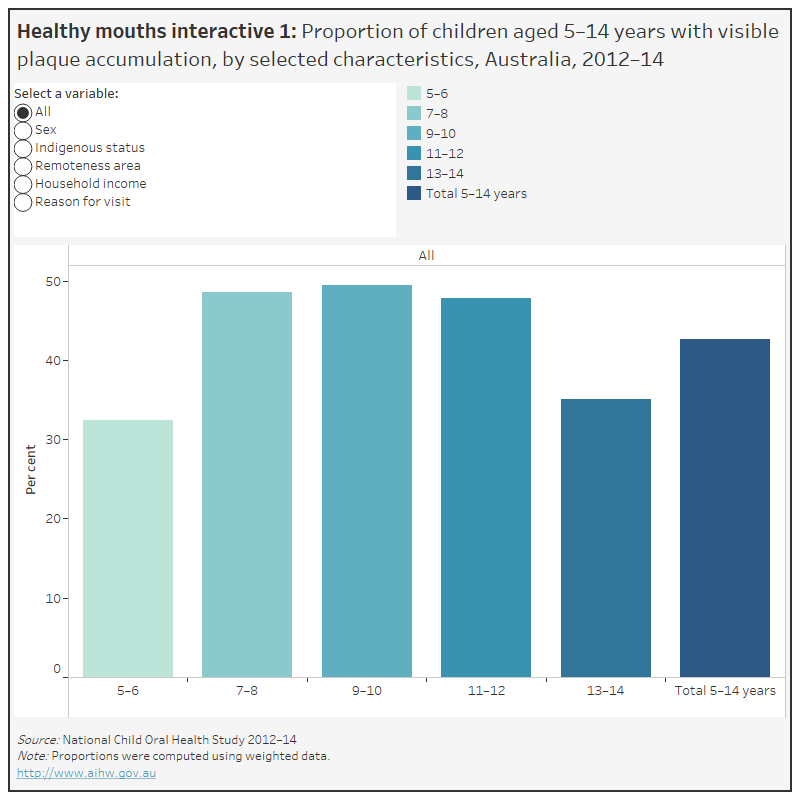
Downloadable data tables are available on Data. See Data tables: Healthy mouths.
Gingivitis
Gingivitis, or early stage gum disease, is usually caused by a build-up of plaque on teeth and along the gum line. The bacteria in plaque produce toxins that can irritate the gums causing inflammation. Data presented in this section were sourced from the National Child Oral Health Study 2012–14 (Do & Spencer 2016), the National Survey of Adult Oral Health 2004–06 (Slade et al. 2007) and the National Study of Adult Oral Health 2017–18 (Do & Luzzi, 2019) which all included a clinical examination component.
Around 1 in 5 (22%) children aged 5–14 years had gingivitis in 2012-14.
In 2012-14, the proportion of children aged 5–14 years with gingivitis was:
- lower for girls (20%) than boys (24%)
- higher for Indigenous children (34%) than non-Indigenous children (21%)
- higher in children from low-income households (26%) than from high-income households (17%)
- higher for children from Remote and very remote (38%) than from Major cities (20%)
- lower for children who last visited the dentist for a check-up (21%) than those who visited for a dental problem (25%).
Around 3 in 10 (29%) adults aged 15 years and over had gingivitis.
In 2017-18, the proportion of adults aged 15 years and over with gingivitis was:
- higher for males (35%) than females (23%)
- higher for people without dental insurance (31%) than those with dental insurance (25%)
- higher for people eligible for public dental care (30%) than those ineligible for public dental care (28%).
Healthy mouths – Interactive 2
This figure shows the proportion of children aged 5–14 years and adults aged 15 years and over with gingivitis, by selected characteristics. National data is presented for children for 2012–14 and for adults for 2004–06 and 2017–18. In2012–14, 21.8% of children aged 5-14 years had gingivitis. 28.8% of adults aged 15 years and over had gingivitis in 2017–18.
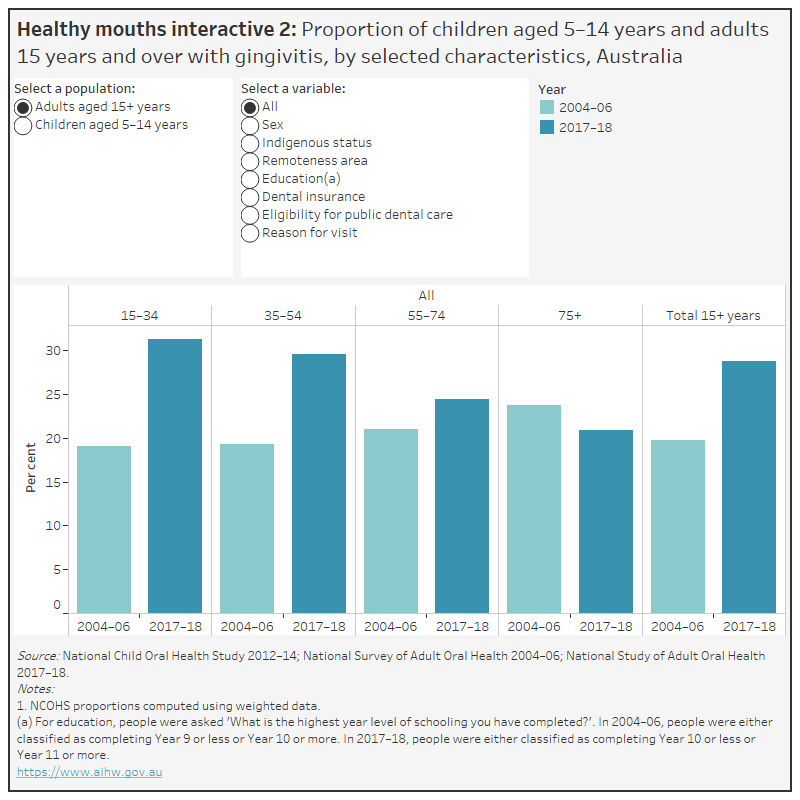
Downloadable data tables are available on Data. See Data tables: Healthy mouths.
Periodontitis
If left untreated, gingivitis can develop into a more serious form of gum disease known as periodontitis. Periodontitis, or advanced stage gum disease, damages the soft tissue and bone supporting the teeth which can cause the teeth to become loose, which in turn can lead to tooth loss. Data presented in this section were sourced from the National Survey of Adult Oral Health 2004–06 (Slade et al. 2007) and the National Study of Adult Oral Health 2017–18 (Do & Luzzi, 2019) which both included a clinical examination component.
The proportion of adults with moderate or severe periodontitis increased with age, ranging from 12% in 15–34 year olds, 33% in 35–54 year olds, 51% in 55–74 year olds and 69% in those aged 75 years and over in 2017–18.
In 2017-18, the proportion of adults aged 15 years and over with moderate or severe periodontitis was:
- higher for males (35%) than females (26%)
- nearly twice as high for those people who had completed Year 10 or less of schooling (45%) than those who had completed Year 11 or more of schooling (26%)
- almost 1.5 times as high for people who last visited the dentist for a problem (37%) than those who last visited for a check-up (26%)
- higher for those people eligible for public dental care (43%) than those people ineligible for public dental care (26%).
Healthy mouths – Interactive 3
This figure shows the proportion of adults aged 15 years and over with periodontitis, by selected characteristics. National data is presented for 2004–06 and 2017–18. In Australia, 30.1% of adults aged 15 years and over had periodontitis in 2017–18.
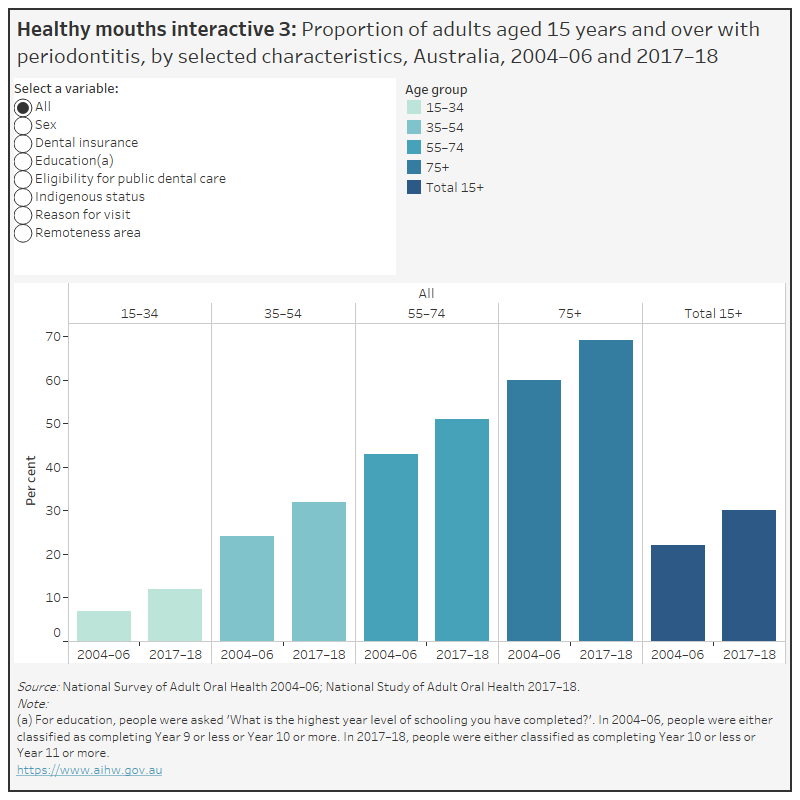
Downloadable data tables are available on Data. See Data tables: Healthy mouths.
Tooth retention and loss
Tooth loss can affect both oral function and appearance, and therefore negatively impact on quality of life. Limited oral function is also associated with deteriorating diet and compromised nutrition, which can adversely impact on overall health (NACDH 2012).
Children with missing teeth
The data presented were sourced from the National Child Oral Health Study 2012–14 (Do & Spencer 2016), which included a clinical examination component, and reflect teeth lost due to dental decay only, and therefore do not include teeth lost due to exfoliation or dental trauma (for example, as a result of injury).
Around 1 in 20 children aged 5–10 years have at least one deciduous tooth missing due to dental caries.
Children aged 5–10 years with at least one deciduous tooth missing due to dental caries were more likely to be:
- Indigenous Australians (9.7%) than non-Indigenous Australians (5.3%)
- from Remote and very remote areas (9.6%) than from Major cities (4.9%)
- from low-income households (9.3%) than from medium-income households (4.3%) and high-income households (2.9%)
- those who last visited the dentist for a dental problem (17%) than those who last visited for a check-up (3.5%).
Around 1 in 100 children aged 6–14 years have as least one permanent tooth missing due to dental caries.
Children aged 6–14 years with at least one permanent tooth missing due to dental caries were more likely to be:
- female (1.0%) than male (0.5%)
- Indigenous Australians (1.4%) than non-Indigenous Australians (0.7%)
- those who last visited the dentist for a dental problem (1.4%) than those who last visited for a check-up (0.6%)
Healthy mouths – Interactive 4
This figure shows the proportion of children aged 5–10 and 6–14 years with missing teeth due to caries, by selected characteristics. National data is presented for 2012–14. In Australia, 5.6% of children aged 5-10 years and 0.8% of children aged 6-14 years had missing teeth due to caries in 2012–14.
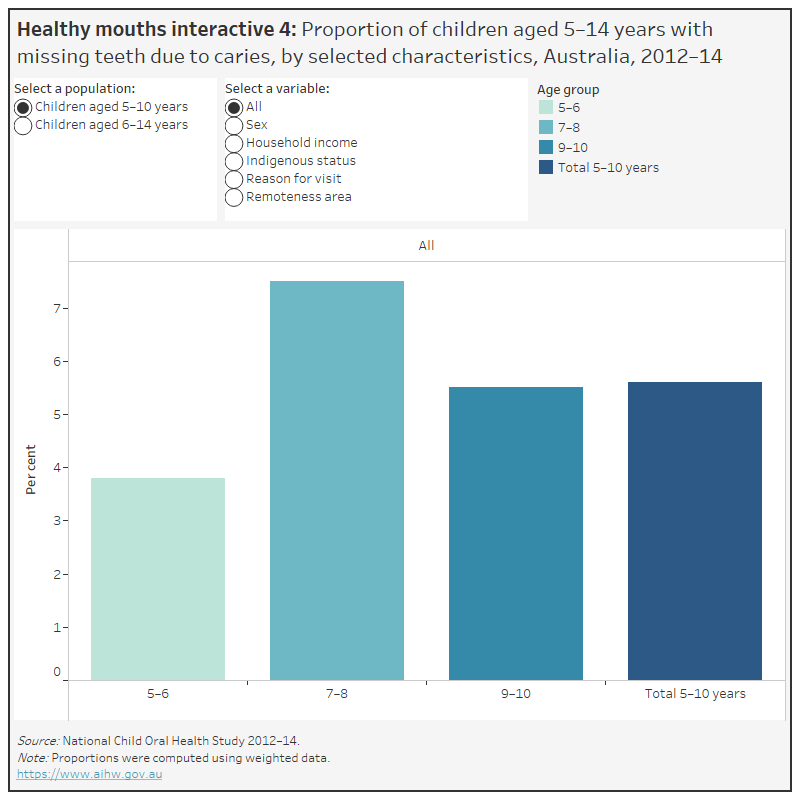
Downloadable data tables are available on Data. See Data tables: Healthy mouths.
Adults with missing teeth
The data presented in this section were sourced from the National Survey of Adult Oral Health 2004–06 (Slade et al. 2007) and the National Study of Adult Oral Health 2017–18 (Do & Luzzi, 2019) which both included a clinical examination component. Adults who have no natural teeth are classified as edentulous, whereas those who have at least one natural tooth are classified as dentate. Only dentate adults were assessed for inadequate dentition (fewer than 21 teeth).
Dentate adults aged 15 years and over had an average of 4.4 teeth missing due to dental decay and periodontal disease in 2017–18.
In 2017–18:
- The average number of missing teeth increased with age, ranging from 0.6 teeth in 15–34 year olds, 3.6 teeth in 35–54 year olds, 8.8 teeth in 55–74 year olds to 13.2 teeth in those aged 75 years and over.
- On average, adults who completed Year 10 or less of schooling had more than twice as many missing teeth as those who completed Year 11 or more of schooling, 7.7 and 3.3 respectively.
- The average number of missing teeth for adults eligible for public dental care (7.6) was more than double that of those ineligible for public dental care (3.0).
The proportion of adults with in adequate dentition (fewer than 21 teeth) increased with age, ranging from 0.7% in 15–34 year olds to 46% in those aged 75 years and over in 2017–18.
In 2017–18:
- On average, 1 in 10 (10%) adults aged 15 years and over had inadequate dentition.
- Adults eligible for public dental care (24%) were around five times as likely to have inadequate dentition than those ineligible for public dental care (4.7%).
- Adults who completed Year 10 or less of schooling (21%) were around four times as likely to have inadequate dentition than those who completed Year 110 or more of schooling (5.9%).
- Adults who had inadequate dentition were more likely to have last visited the dentist for a dental problem (18%) rather than for a check-up (6%).
The proportion of adults with complete tooth loss increased with age, ranging from 1.1% in 35–54 year olds, 8.1% in 55–74 year olds to 21% in those aged 75 years and over. There were no 15–34 year olds with complete tooth loss in 2017–18.
In 2017–18:
- On average, 1 in 25 (4.0%) adults aged 15 years and over had complete tooth loss.
- Adults eligible for public dental care (11%) were around nine times as likely to suffer complete tooth loss than those ineligible for public dental care (1.2%).
- Adults who completed Year 10 or less of schooling (9.4%) were around five times as likely to suffer complete tooth loss than those who completed Year 11 or more of schooling (1.8%).
- Adults without dental insurance (6.5%) were more likely to suffer complete tooth loss than those with dental insurance (1.7%).
Healthy mouths – Interactive 5
This figure shows the proportion of adults aged 15 years and over with missing teeth, inadequate dentition or complete tooth loss. National data is presented for 2004–06 and 2017–18. Fewer, adults had complete tooth loss in 2017–18 (4.0%) than in 2004–06 (6.4%).
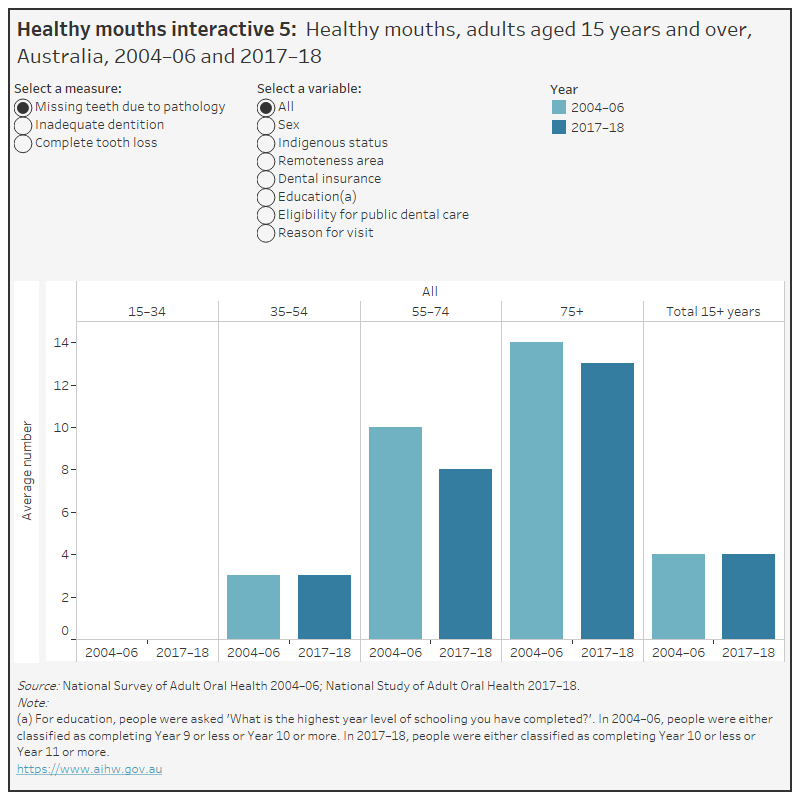
Downloadable data tables are available on Data. See Data tables: Healthy mouths.
Healthy mouths across Australia
In this section measures of oral health status in adults aged 15 years and over, such as periodontal disease and tooth retention and loss, are compared across states and territories. Data presented were sourced from the National Survey of Adult Oral Health 2004–06 (Slade et al. 2007; AIHW 2008a–2008h) and the National Study of Adult Oral Health 2017–18 (Do & Luzzi, 2019) which both included a clinical examination component.
The proportion of adults aged 15 years and over with periodontal disease varied between states and territories with nearly twice as many adults with periodontal disease in Queensland (37%) than in South Australia (21%) in 2017–18.
Explore the data for Healthy mouths by state and territory further:
Healthy mouths – Interactive 6
This figure shows various measures of dental health for adults aged 15 years and over. State and territory data is presented for 2004–06 and 2017–18. In 2017–18, the Australian Capital Territory had the lowest proportion of adults with inadequate dentition (6.4%) and Tasmania had the highest (15.0%).
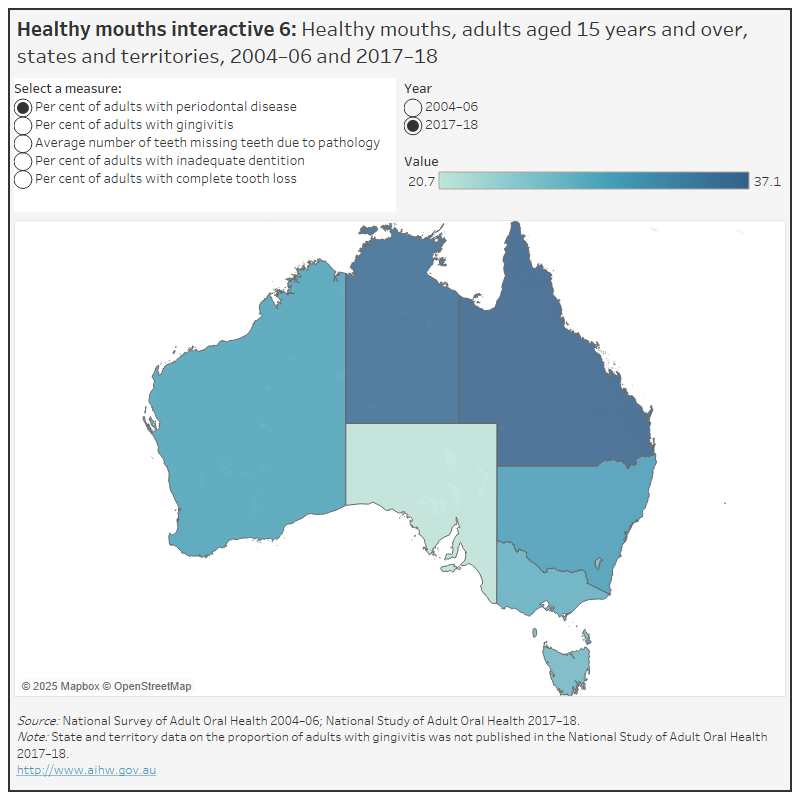
Downloadable data tables are available on Data. See Data tables: Healthy mouths.
Self-reported measures of oral health
The data presented in this section was sourced from the National Dental Telephone Interview Survey 2021 (Luzzi et al 2023), which included measures of self-reported oral health status, use of and access to dental services, social impact of oral health, financial burden of dental care and private health insurance that covered dental expenses. There was no clinical component to the survey.
In 2021, around 1 in 10 (11%) adults aged 18 years and over reported they had gum disease.
- The proportion of adults who reported they had gum disease ranged from 7.1% in 18–34 year olds to 15% in 55–74 year olds.
- Around twice as many adults who usually visited the dentist for a dental problem (18%) reported they had gum disease than those who usually visited the dentist for a check-up (8.7%).
In 2021, around 1 in 12 (8.6%) adults aged 18 years and over reported they had an inadequate dentition.
- The proportion of adults who reported having an inadequate dentition increased with age, with around 4 in 10 (37%) adults aged 75 years and over reporting they had an inadequate dentition.
- Around 1 in 4 (23%) adults eligible for public dental care reported they had an inadequate dentition compared to around 1 in 25 (3.8%) adults ineligible for public dental care.
- The proportion of adults reporting they had an inadequate dentition decreased over time, from 19% in 1994 to 7.5% in 2021.
In 2021, around 1 in 25 (3.5%) adults aged 18 years and over reported complete tooth loss.
- The proportion of adults who reported complete tooth loss increased as remoteness increased, ranging from 3.0% in Major cities to 4.6% in Inner regional areas and 5.7% in Outer regional and remote areas.
- Around twice as many adults without dental insurance (4.9%) reported complete tooth loss than those with dental insurance (2.3%).
- The proportion of adults reporting they had complete tooth loss decreased over time, from 13% in 1994 to 3.0% in 2021.
Explore the data further in the interactives below.
Healthy mouths – Interactive 7
This figure shows 3 self-reported measures of dental health, gum disease, inadequate dentition and complete tooth loss, for adults aged 18 years and over. Various demographic data is presented for 2021. Adults aged 75 years and over were the highest proportion reporting inadequate dentition (37.3%) and complete tooth loss (12.9%). A higher proportion of Indigenous people reported gum disease (19.4%) than non-Indigenous people (11.2%).
Healthy mouths – Interactive 8
This figure shows the trends in 2 self-reported measures of dental health, inadequate dentition and complete tooth loss for adults aged 18 years and over from 1994 to 2021. For all adults, complete tooth loss has decreased from 12.6% in 1994 to 3.0% in 2021. For adults aged 75 years and over inadequate dentition has decreased from 63.0% in 1994 to 37.5% in 2021.

Downloadable data tables are available on Data. See Data tables: Healthy mouths.
AIHW (Australian Institute of Health and Welfare) Dental Statistics and Research Unit 2008a. The National Survey of Adult Oral Health 2004–06: Australian Capital Territory. Cat. no. DEN 175. Dental Statistics and Research series no. 39. Canberra: AIHW.
AIHW Dental Statistics and Research Unit 2008b. The National Survey of Adult Oral Health 2004–06: New South Wales. Cat. no. DEN 176. Dental Statistics and Research series no. 40. Canberra: AIHW.
AIHW Dental Statistics and Research Unit 2008c. The National Survey of Adult Oral Health 2004–06: Northern Territory. Cat. no. DEN 177. Dental Statistics and Research series no. 41. Canberra: AIHW.
AIHW Dental Statistics and Research Unit 2008d. The National Survey of Adult Oral Health 2004–06: Queensland. Cat. no. DEN 178. Dental Statistics and Research series no. 42. Canberra: AIHW.
AIHW Dental Statistics and Research Unit 2008e. The National Survey of Adult Oral Health 2004–06: South Australia. Cat. no. DEN 179. Dental Statistics and Research series no. 43. Canberra: AIHW.
AIHW Dental Statistics and Research Unit 2008f. The National Survey of Adult Oral Health 2004–06: Tasmania. Cat. no. DEN 180. Dental Statistics and Research series no. 44. Canberra: AIHW.
AIHW Dental Statistics and Research Unit 2008g. The National Survey of Adult Oral Health 2004–06: Victoria. Cat. no. DEN 181. Dental Statistics and Research series no. 45. Canberra: AIHW.
AIHW Dental Statistics and Research Unit 2008h. The National Survey of Adult Oral Health 2004–06: Western Australia. Cat. no. DEN 182. Dental Statistics and Research series no. 46. Canberra: AIHW.
Department of Health and Aged Care 2018. Healthdirect – Teeth cleaning. Canberra: Australian Government Department of Health. Viewed 26 September 2018.
Do L & Luzzi L 2019. Oral Health Status. p38-96. In: ARCPOH. Australia’s Oral Health: National Study of Adult Oral Health 2017–18. Adelaide: The University of Adelaide, South Australia.
Do LG & Spencer AJ (editors) 2016. Oral health of Australian children: the National Child Oral Health Study 2012–14. Adelaide: University of Adelaide Press.
Luzzi, L., Chrisopoulos, S. and Brennan, D.S. (2023). Adult Oral Health and Access to Dental Care in Australia: Results from the National Dental Telephone Interview Survey 2021. Adelaide: The University of Adelaide, South Australia. Accessed at: National Dental Telephone Interview Survey (NDTIS) Findings | Australian Research Centre for Population Oral Health | University of Adelaide
NACDH (National Advisory Council on Dental Health) 2012. Report of the National Advisory Council on Dental Health 2012. Canberra: Department of Health and Ageing.
Slade GD, Spencer AJ, Roberts-Thomson KF (Editors) 2007. Australia’s dental generations: the National Survey of Adult Oral Health 2004–06. Dental statistics and research series no. 34. AIHW cat. no. DEN 165. Canberra: AIHW.


